B2.4 Represent and solve problems involving the addition and subtraction of whole numbers that add up to no more than 100 000, and of decimal numbers up to hundredths, using appropriate tools, strategies, and algorithms.
Skill: Representing and Solving Addition and Subtraction Problems Using Strategies Including Algorithms
The learning of mathematical operations takes place gradually. The starting point should be the exploration of operations in problem-solving situations. Students learn to associate situations with particular operations, which allows them to begin to make sense of the operations. Students need to use strategies based on their understanding of the context, the problem, and the operations. Students become aware that there are many ways to solve a problem and even many ways to carry out the same operation. Subsequently, students should be asked to solve a variety of problems in order to progress to using effective strategies.
In contrast to the traditional approach where students learn to apply standard algorithms, operations learning should be more oriented towards understanding operations, exploring mental math and using various strategies to perform operations. It is in this sense that the mathematics curriculum includes the expectation for students in the junior grades to be able to solve problems related to the operations being studied using a variety of strategies or personal algorithms.
Source: translated from Guide d'enseignement efficace des mathématiques de la 4e à la 6e année, Numération et sens du nombre, Fascicule 1, Nombres naturels, p. 75-76.
Written Problems: Addition and Subtraction
There are four types of problems in addition and subtraction: changing (joining and separating), combining (part-part-whole) and comparing. In order for students to understand the connections between quantities in each of these cases, it is important that they be presented with a variety of problem types. The following table presents a variety of addition and subtraction problems.
Addition and subtraction are operations that can be used to solve problems. It is important to avoid referring to problems as "subtraction problems" or "addition problems" because it is the understanding of the situation that leads to the choice of using addition or subtraction to solve it. Thus, students must analyze the problem, choose a strategy and apply it, just as adults do. In this context, the teacher's role is to assist students in their analysis and understanding of operations.
It is important to note that the problems presented below appear similar because of their context. However, for students, each situation represents a unique problem. It is through experience with these different types of problems that students will become proficient with addition and subtraction.
Source: translated from Guide d'enseignement efficace des mathématiques de la 4e à la 6e année, Numération et sens du nombre, Fascicule 1, Nombres naturels, p. 81.
Join Problems
The part-whole model can be useful for representing known and unknown values in joining problems. The set model is useful for representing the joining of a quantity to another.
- Joining: Result (Final quantity) Unknown
Jamil has a bag of 600 candies. He buys 500 more pieces of candy. How many pieces of candy does Jamil have now?
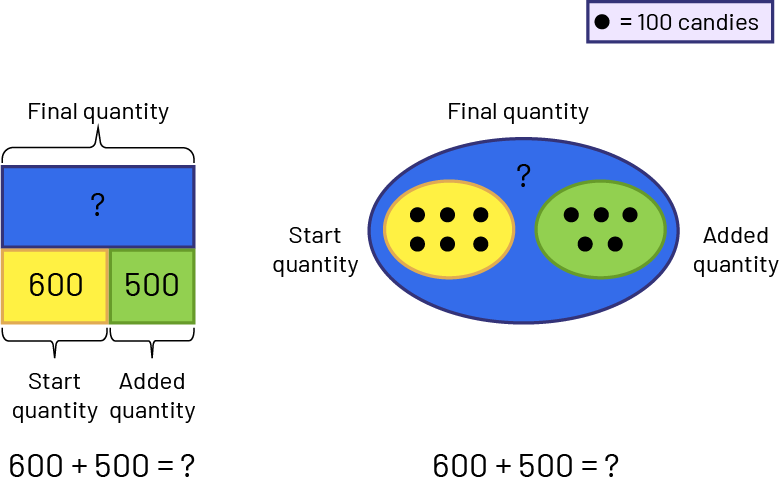
- Joining: Start (Initial quantity) Unknown
Jamil has a lot of candy. He buys 500 more. He now has 1100. How many pieces of candy did Jamil have to start?
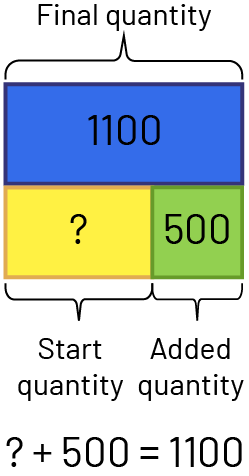
- Joining: Change (Added quantity) Unknown
Jamil has a bag of 600 candies. He buys many more. He now has 1100 pieces. How much candy did Jamil buy?
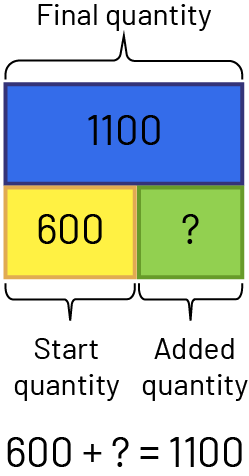
Separate Problems
The part-whole model can be useful for representing known and unknown values in separating problems. The set model is useful for representing the seperation of a quantity.
- Separating: Result (Final quantity) Unknown
Nadia has $1500. She gives $500 to her brother. How many dollars does she have left?
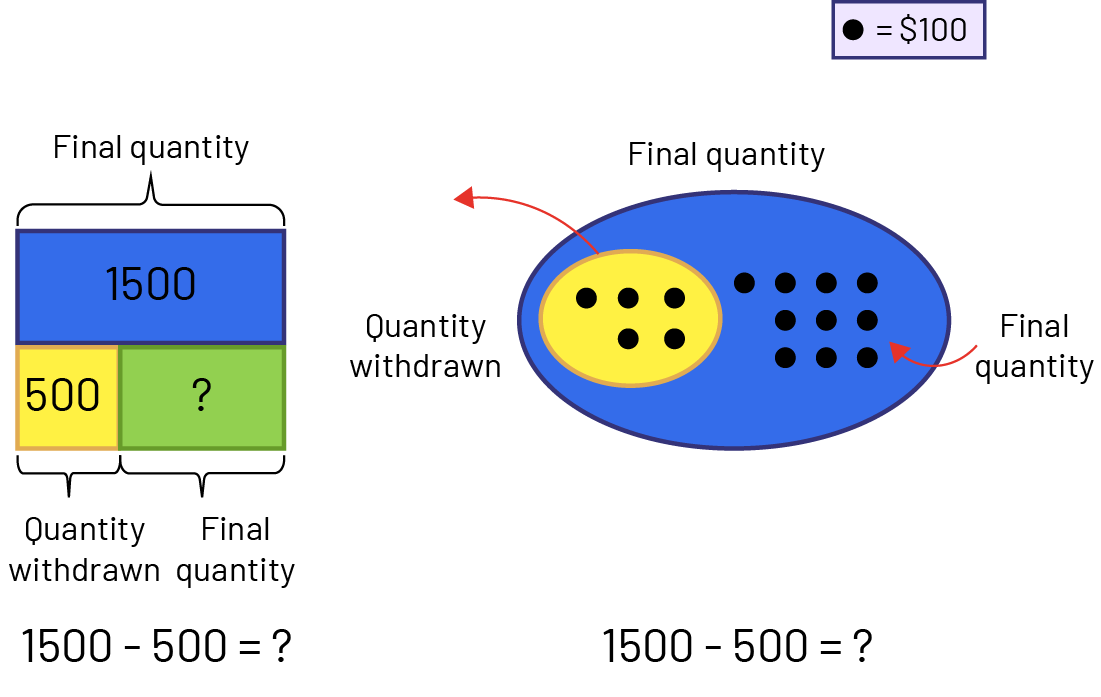
- Separating: Change (Withdrawn quantity) Unknown
Nadia has $1500. She gives some money to her brother. She now has $1000 left. How much did Nadia give her brother?

- Separating: Start (Initial quantity) Unknown
Nadia gave $500 to her brother. She has $1000 left. How much money did Nadia have at the beginning?

Combine (Part-Part-Whole) Problems
The part-whole model can be useful for representing known and unknown parts or the known and unknown whole in combining problems.
- Combining: Part Unknown
The class has 800 crayons. 300 of these crayons are red. The remaining crayons are blue. How many blue crayons does the class have?
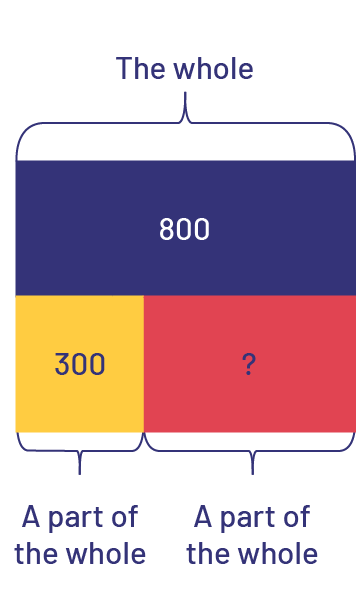
- Combining: Whole Unknown
The class has lots of crayons. There are 300 red crayons and 500 blue crayons. How many crayons does the class have?
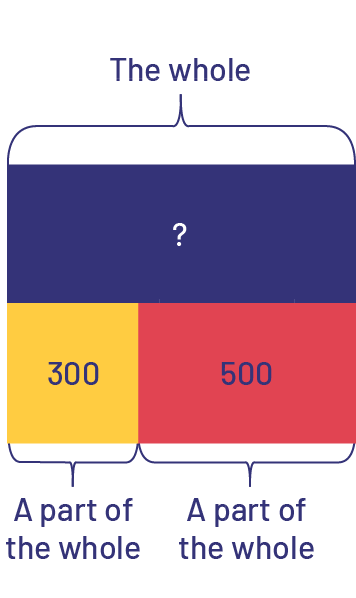
Comparing Problems
The linear model can be useful for representing the difference between two numbers in comparing problems. In this example, we use relational rods and a double number line.
- Comparing: Difference Unknown
Judith has $600 and Jeanne has $300. How many more dollars does Judith have than Jeanne? OR Judith has $600 and Jeanne has $300. How much less does Jeanne have than Judith?
I know that the dark green rod represents 6 (hundreds), so I placed it at the top of the number line starting at 0. I know that the lime green rod represents 3 (hundreds), so I placed it below the number line starting at 0. I compared the two rods and saw that the lime green rod represents 3 (hundreds) less than the dark green rod. I found the difference or gap between the 2 quantities. There is a difference of $300. Judith has $300 more than Jeanne or Jeanne has $300 less than Judith.
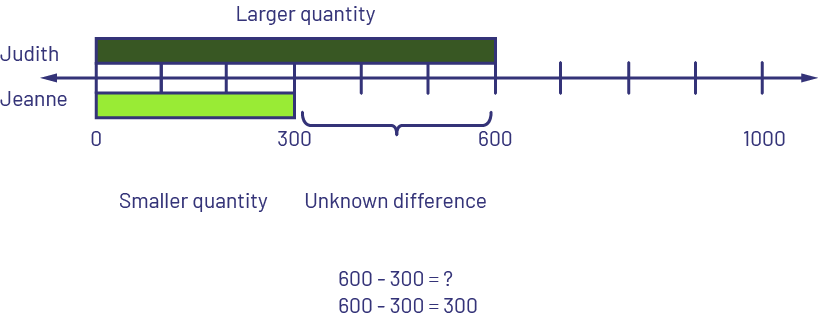
- Comparing: Larger Quantity Unknown
Judith has $300 more than Jeanne. Jeanne has $300. How much money does Judith have? OR Jeanne has $300 less than Judith. Jeanne has $300. How much money does Judith have?
I know that the lime green rod represents 3 (hundreds), so I place it at the top of the number line starting at 0. I took another lime green rod and placed it under the number line starting at 0 and added another lime green rod since Judith has $300 more than Jeanne. I replaced the two lime green rods with the dark green rod which represents 6 (hundreds). Judith has $600.

\(?\; - \;300\; = \;300\)
- Comparing: Smaller Quantity Unknown
Judith has $600 and Jeanne has $300 less than Judith. How much money does Jeanne have? OR Jeanne has $300 less than Judith. Judith has $600. How much money does Jeanne have?
I know that the dark green rod represents 6 (hundreds), so I placed it at the top of the number line starting at 0. On the number line, I counted backwards 3 jumps to 300 to represent that Jeanne has $300 less than Judith. I took a lime green rod, which represents 3 (hundreds), and placed it under the number line starting at 0. Jeanne has $300.

\(600\; - \;?\; = \;300\)
Source: translated from Guide d'enseignement efficace des mathématiques de la maternelle à la 6e année, Fascicule 5, p. 9-10.
Joining and separating problems are perceived by students as active situations, easier to model and "see" as the initial quantity increases or decreases. Combining (part-part-whole) problems, however, assume a static situation, as no action or change occurs, making them more abstract and difficult to understand. Comparing problems, on the other hand, deal with the relationship between two quantities by finding the difference between them: so there is no action, but a comparison of one quantity to another.
Since students are regularly exposed to problems whose final quantity is sought, they solve these kind of problems and have more difficulty solving problems where the unknown is the starting quantity, added quantity, or removed quantity. These variations of problems help develop a more solid understanding of addition and subtraction and the relationships between them. For example, in the case of joining problems where the unknown is the start quantity, students more easily see the advantages of addition (for example, \(?\; + \;12\; = \;37 \)) which makes it possible to respect the order in which the action takes place in the problem. This allows them to use a strategy (for example, counting up or down) to determine the initial quantity. These students demonstrate their understanding of the problem and their ability to use a strategy to solve it. However, they do not demonstrate an understanding of the meaning of difference (and subtraction). If they had used the subtraction \(37\; - \;12\; = \;?\), they would have demonstrated a broader understanding of the relationships between the quantities. Having said that, a strategy should not be imposed on students while they are learning.
Requiring students to subtract will not help students who do not see the relevance of this strategy. However, if they are regularly exposed to a variety of problems and participate in the mathematical discussions that follow, they will begin to see the connections between various strategies and learn a variety of strategies. They then become more successful.
Source: translated from Guide d'enseignement efficace des mathématiques de la 4e à la 6e année, Numération et sens du nombre, Fascicule 1, Nombres naturels, p. 83-84.
Computational Strategies
Personal or invented strategies offer several advantages over traditional instruction of standard algorithms, starting with the pride and confidence they foster. Students who use personal algorithms make fewer mistakes because they understand what they are doing. They also improve their knowledge and understanding of the base ten system, on which most computational strategies are based.
Furthermore, Van de Walle and Lovin (2006, p. 40) point out that research shows that students who have been able to develop personal strategies perform as well as or better than others on standardized tests.
There are major differences between personal algorithms and standard algorithms. Personal algorithms are usually oriented towards the meaning of the digits, according to their position (for example, in the addition 323 + 20, I add 2 tens to 323, which gives 343) whereas standard algorithms tend to use the digits without taking their position into account (for example, in the addition \(323 + \;20\), we do: \(3\; + \;0\), that's 3; \(2\; + \;2\), that's 4…).
Standard algorithms usually start on the right, whereas in their personal algorithms, students often start on the left, enabling them to maintain a sense of the magnitude of the quantities involved. Since a personal algorithm is the fruit of each student's imagination and understanding, it remains highly flexible, so that it can be used in a variety of situations.
In the classroom, it is suggested that several algorithms for a single operation be examined. It is essential that students understand the reasoning behind the actions in these algorithms. Over time, this allows them to choose an effective strategy depending on the context. Teachers with culturally diverse students in their classrooms can invite them to discuss at home the method their parents use to add, subtract, multiply or divide. Students can then present these methods to the class, which can provide students with additional strategies.
The standard algorithms are often presented as the main strategy for calculation. Although they are effective, they are not always appropriate. When instruction focuses on the standard algorithm, students tend to pull out a pencil and paper to calculate \(300\; - \;15\), and often make errors related to the complex regrouping. However, it is actually more efficient to calculate this mentally as follows: \(300\; - \;10\; = \;290,\;290\; - \;5\; = \;285\) or even to think about it as getting back change. Furthermore, the standard algorithm is not the best method to use where estimation is sufficient. Therefore, it is suggested that the standard algorithm be considered as only one of several computational strategies.
Source: translated from Guide d'enseignement efficace des mathématiques de la 4e à la 6e année, Numération et sens du nombre, Fascicule 1, Nombres naturels, p. 118-119.
Students can solve written problems in a variety of ways. The following tables provide some examples of addition and subtraction algorithms. These are not the only ways to solve a problem. There are many others. Students should be given opportunities to reason other ways.
Some algorithms that students can use to determine the sum of 566 + 379 follow. There are others and they will vary from one group of students to another.
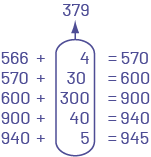
The student proceeds in steps, decomposing the last second addend, until a total of 379 is added.
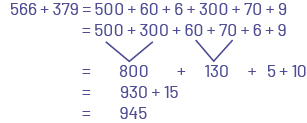
The student decomposes both addends horizontally and then recomposes them by place values.

The student groups and adds by place value, starting with hundreds, then tens and finally ones.

The student uses a compensation technique on the addends to make them easier to work and then decomposes and recomposes them.
The following are examples of algorithms that students can use to determine the difference for 631 - 439 and explain their strategy. There are others and they will vary from one group of students to another.
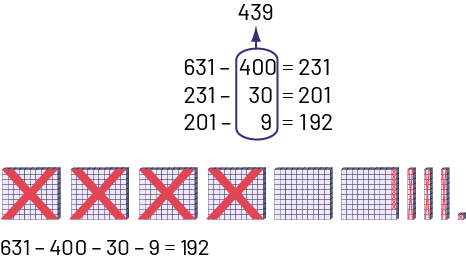
The student decomposes the second term and subtracts it in steps until a total of 439 is taken away.

The student adds to subtract by making jumps on a number line, beginning at 439 and ending at 631.
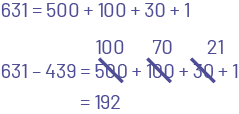
The student decomposes the first term and then subtracts the second term, 500 - 400 = 100; 100 - 30 = 70; 30 - 9 = 21, which is recomposed as 100 + 70 + 21 + 1 = 192.
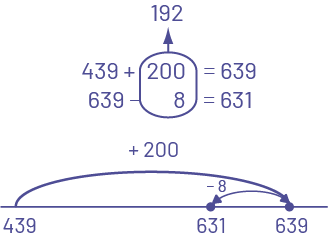
The student uses the number line and records their movements.
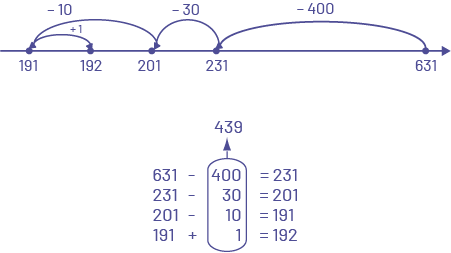
The student uses the number line and counts backwards a total of 439 from 631.
Strategies to Facilitate the Understanding of Standard Algorithms
It is important to provide students with several activities to explore standard algorithms using manipulatives such as the place-value mat, interlocking cubes, ten frames, base ten blocks, number lines, etc.
Teachers need to provide students with many opportunities to create their own algorithms, to explain their strategies and the reasons for their choices. It is important to give students the opportunity and time to explore the algorithms in greater depth and to encourage discussion. It is important to encourage students to work in pairs (one student writes down the steps while the other works with the concrete representation). Understanding of the meaning of the steps in a standard algorithm develops when teachers allow students to compare it to their own algorithm in order to make connections between the two approaches, such as "add from left to right and combine".
Adding Multi-Digit Numbers Without Grouping
Adding large numbers can be represented on a number line. For example, students could perform \(435\; + \;223\) by decomposing 223 into \(200 + 15 + 8 \) and representing the operation as follows:
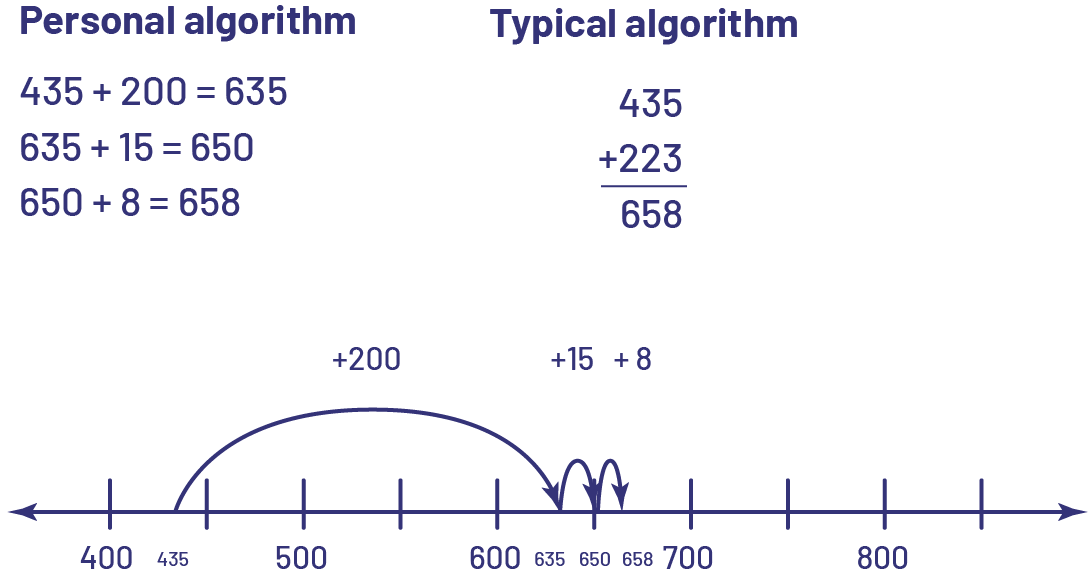
Over time, students gradually develop their sense of abstraction and can use the same strategy without using a number line but by performing the calculation mentally.
Source: translated from Guide d'enseignement efficace des mathématiques de la 4e à la 6e année, Numération et sens du nombre, Fascicule 1, Nombres naturels, p. 122-123.
Adding Multi-Digit Numbers with Grouping
(Van de Walle and Folk, 2005, p. 191)
It is important for students to practice changing groups of 10 ones into tens, groups of 10 tens into hundreds, and so on. They need the support of visual representations of groupings to develop a conceptual understanding of the algorithm.
Source: translated from Guide d'enseignement efficace des mathématiques de la maternelle à la 6e année, Fascicule 5, p. 57.
Base ten blocks helps some students visualize the operation more clearly by allowing them to regroup by exchanging ten rods for a flat, for example:
Example
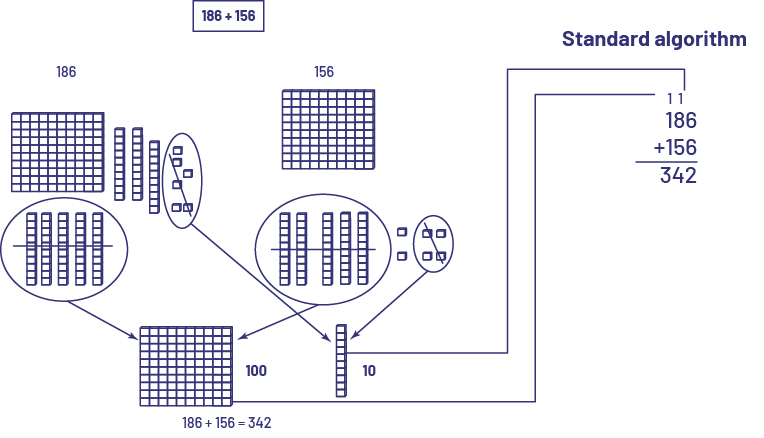
Students can also use a place value mat that organizes the blocks by the position of the digit in the number.

The same numeric expression (\(186\; + \;156\)) can be represented using visuals that a student chooses. In this way, students demonstrate some level of abstraction since a drawing is used to represent 100, 10 or 1.
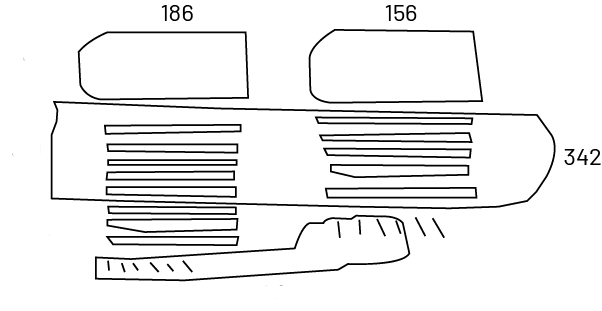
Source: translated from Guide d'enseignement efficace des mathématiques de la 4e à la 6e année, Numération et sens du nombre, Fascicule 1, Nombres naturels, p. 123-124.
Subtraction Without Regrouping
As with addition, students often use manipulatives to perform subtraction. This strategy helps them grasp the concept of separation, although it is not very effective when dealing with large numbers.

Base ten blocks allow students to perform subtraction by separating or removing.
Example 1
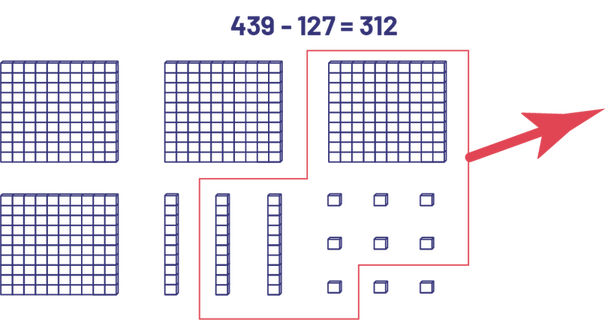
If students use the place value mat for subtraction, some will represent the both terms. In this case, subtraction is performed by comparison.
Example 2
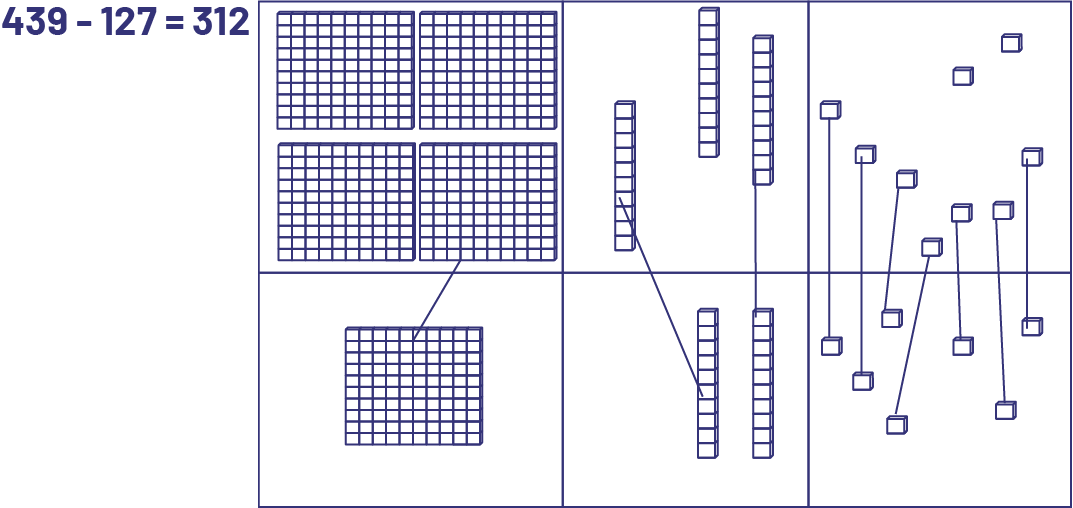
Source: translated from Guide d'enseignement efficace des mathématiques de la 4e à la 6e année, Numération et sens du nombre, Fascicule 1, Nombres naturels, p. 127-128.
Subtraction With Regrouping
(Van de Walle and Folk, 2005, p. 193)
Exploring subtraction with regrouping promotes conceptual understanding. Teachers should encourage students to use the place value mat and base ten blocks to model subtraction with regrouping. Students can work in pairs. They can move on to the written form of the algorithm once they have developed a solid understanding through modelling.
In the case of the calculation \(325\; - \;118\), students represent the 1st number (325) with base ten blocks on the top portion of the place value mat. They cannot remove 8 ones since there are only 5, so students regroup to get one ten for 10 ones.
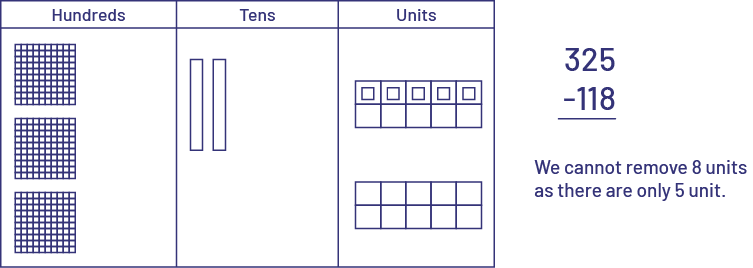
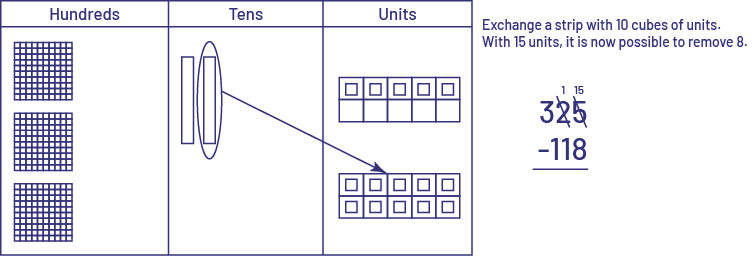
This gives them a group of 15 ones from which they can now remove 8 so that 7 ones remain. Students should be encouraged to group the ones on the mat to better organize their work.
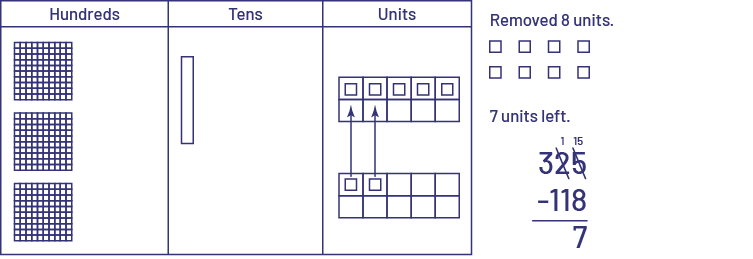
Students now remove 1 ten and 1 hundred and place them outside the mat.
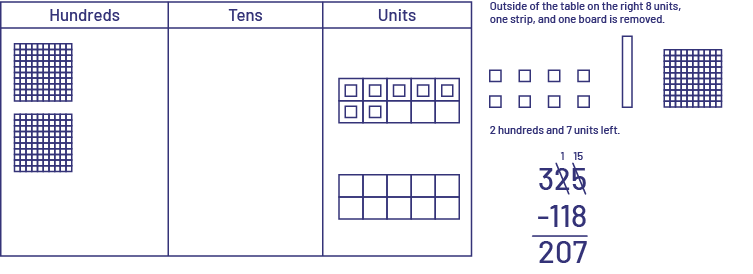
Source: translated from Guide d'enseignement efficace des mathématiques de la maternelle à la 6e année, Fascicule 5, p. 58-59.
Students can also use the number line to perform a subtraction. For example, to calculate \(263\; - \;45\), they can use compensation to work with "friendlier" numbers. Since \(263\; + \;2\; = \;265\), it is easier to determine \(265\; - \;45\; = \;220\) and then subtract 2 to compensate \((263\; + \;2\; - \;45\; - \;2)\).
Students can show their thinking on the number line by labelling the jumps:

The number line can also be used with the decomposition by removing in jumps according to the place values of the subtrahend, or number being removed: (263 – 40 = 223, 223 – 5 = 218):

The open number line allows students to proceed in significant leaps (263 – 3 = 260, 260 − 40 = 220, 220 – 2 = 218):

Source: translated from Guide d'enseignement efficace des mathématiques de la 4e à la 6e année, Numération et sens du nombre, Fascicule 1, Nombres naturels, p. 127.
Students can use drawings to quickly illustrate a number expression such as \(1\;369 - 821\). Numbers can be represented by lines, circles, dots, etc. A separation or removal can be expressed by hatch marks on the drawing. For \(1\;369\; - \,821\), we must remove 8 hundreds, 2 tens and 1 one from the 13 hundreds, 6 tens and 9 ones.

Skill: Representing and Solving Problems Involving Addition and Subtraction of Decimal Numbers to Hundredths
To add decimal numbers effectively, students need to understand the place value of the digits that make up each number and factor this into their calculations. Students must also recognize that the decimal point is a marker that identifies the place value of the digits. When adding, to ensure that the place values correspond, decimal points can be aligned. For students who have a good sense of addition and place value, aligning the decimal point is not a rule to be memorized, but a way to account for place values.
When adding decimal numbers, the concept of grouping is used just as when adding whole numbers. For example, just as we can add 3 hundreds to 8 hundreds to form 11 hundreds, we can add 3 tenths to 8 tenths to form 11 tenths. However, since the decimal system does not allow 2 digits to be placed in the same position, students need to understand the concept of regrouping, as illustrated in the table below.
| Addition of Whole Numbers | Addition of Decimal Numbers |
|---|---|
|
8 hundreds + 3 hundreds = 11 hundreds (The small cube 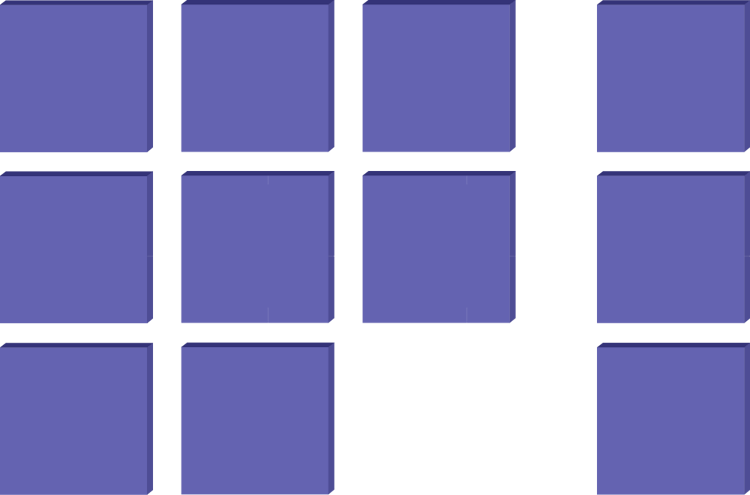 |
8 tenths + 3 tenths = 11 tenths (The rod  |
|
The decimal system does not allow two digits to be entered in the same position. 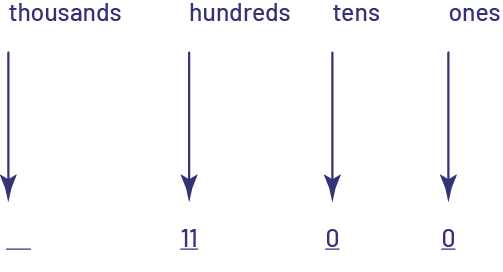 |
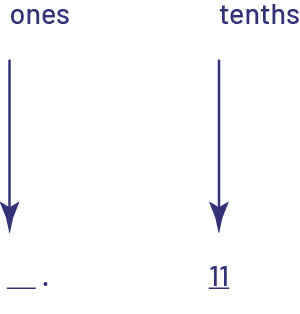 |
Since 10 hundreds can be grouped into 1 thousand, we have 1 thousand and 1 hundred.

The quantity "11 hundreds" is written as 1100. |
Since 10 tenths can be grouped into 1 one, we have 1 one and 1 tenth. 
The quantity "11 tenths" is written as 1.1. |
When learning how to add and subtract decimal numbers, base 10 ten blocks and the place value mat are a great support. With these materials, parts that have the same value can be physically combined. For example, hundredths are added together with hundredths. When students work with base ten blocks, they transfer their knowledge of place value and grouping from working with whole numbers to situations involving decimal numbers. Students recognize that regardless of place value, whenever 10 elements are in one position, they can be replaced by 1 group of the element in the position to the left.
Using these types of materials increases students' understanding and introduces them to algorithms for adding decimal numbers. Based on their knowledge of addition strategies for whole number and their understanding of decimal numbers, students can add them using base ten materials, a number line, a personal algorithm, or the standard algorithm. It is important for teachers to engage students in making connections between these strategies in order to consolidate addition of decimal numbers.
Here are different strategies for adding two decimal numbers:
Example
\(1.57\; + \;2.72\)
In order to estimate the sum, it is possible to reason as follows: \(1.57\; + \;2.72\) is about \(2\; + \;3\), so about 5.
Addition Using Base Ten Blocks
To add the two quantities, represent each of the two numbers using base ten blocks on a place value mat. Putting all the material together, we get 3 ones, 12 tenths and 9 hundredths. We combine 10 tenths that we exchange for 1 one. We then have 4 ones, 2 tenths and 9 hundredths, or 4.29.

Addition Using a Number Line
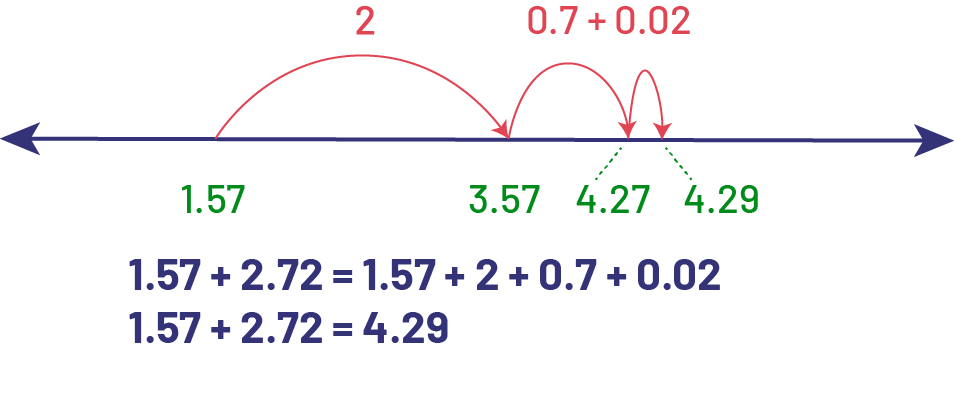
Addition Using a Personal Algorithm
Numbers are decomposed according to place values.
Example
Student reasoning
\(\begin{align} 1.57 + 2.72 \\ 0.07\; + \;0.02\; &= \;0.09\\0.5\; + \;0.7\; &= \;1.2\\1\; + \;2\; &= \;3\end{align}\) \(1.57\; + \;2.72\;\;\;{\rm{is\;\;\;\; the\;\; same \;\;\;as }}\;0.09\; + \;1.2\; + \;3\;\;\;{\rm{or}}\;\;\;{\rm{4}}{\rm{.29}}{\rm{.}}\)
- 7 hundredths plus 2 hundredths gives 9 hundredths (0.09).
- 5 tenths plus 7 tenths gives 12 tenths, which is equivalent to 1 one and 2 tenths (1.2).
- 1 one plus 2 ones is 3 ones.
- So 1.57 + 2.72 is 0.09 + 1.2 +3 or 4.29
Addition Using a Standard Algorithm
Example
Student reasoning

During subtraction, it is important, as it was with addition, to consider the place value of the digits that make up the numbers. The strategies for subtracting decimal numbers are essentially the same as those used for subtracting whole numbers.
Subtraction Using Base Ten Blocks
When students use concrete materials to represent subtraction, students can actually manipulate the quantities involved. To determine a difference, students can compare one quantity to another or take one quantity away from another. Through the use of these materials, students discover that sometimes it is necessary to regroup in order to more easily determine the difference between quantities.
- Example of comparison
\(3.46\; - \;1.21\)
Model each number using base ten materials and match like quantities (in red) in each position. The difference is represented by the quantities that remain unmatched in the number 3.46 (in blue). Thus, we get \(3.46\; - \;1.21\; = \;2.25\).

- Example with separating
\(3.40\; - \;2.1\)
The number 3.40 is represented using base ten materials. Then the equivalent of the number 2.1 is removed. The difference between the two numbers, which is 1.3, remains on the mat.
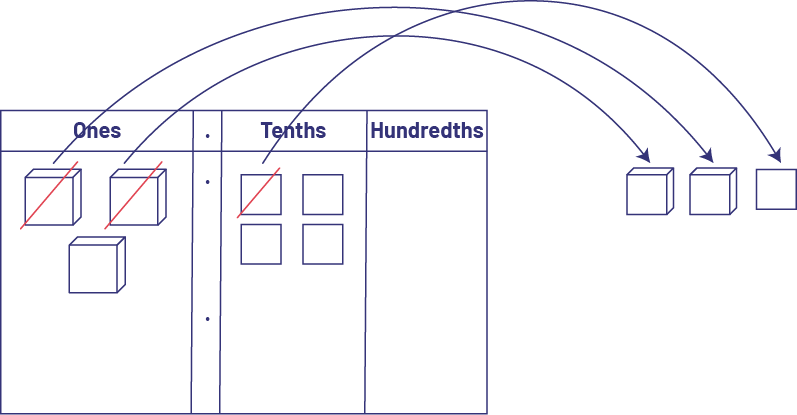
- Example of regrouping
\(2.42\; - \;1.26\)
The number 2.42 is represented using base ten materials. When we try to use the separating strategy to perform the subtraction, we realize that there are only 2 hundredths on the mat when we need to remove 6 hundredths. In this case, we can exchange 1 tenth for 10 hundredths. We can then remove the equivalent of the number 1.26.
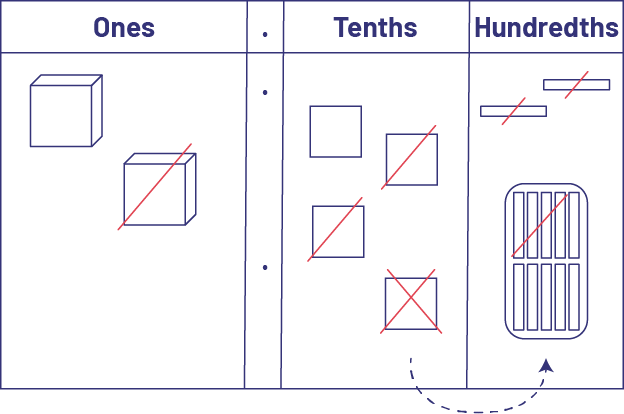
The difference between the two numbers is 1.16, which is the quantity that remains on the mat.
Subtraction Using a Number Line
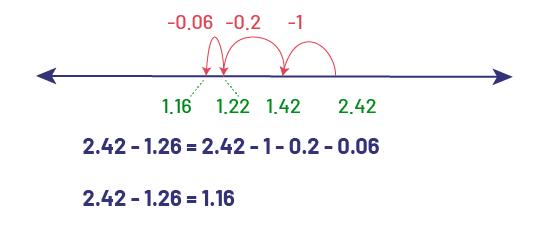
Subtraction Using a Personal Algorithm
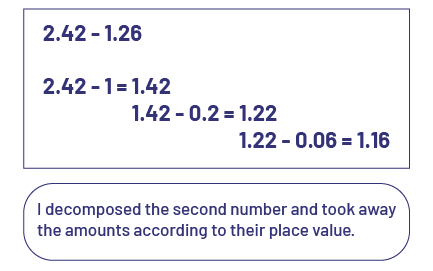
Subtraction Using a Standard Algorithm
We can use a standard algorithm for subtraction with decimal numbers. However, you have to make sure to match the place values.
Student reasoning
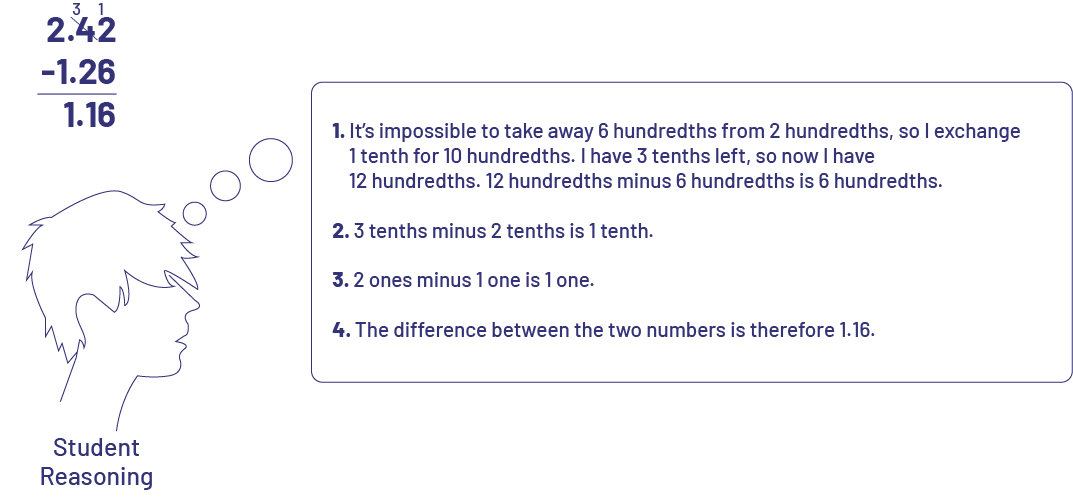
Source: translated from Guide d'enseignement des mathématiques de la 4e à la 6e année, Numération et sens du nombre, Fascicule 3, Nombres décimaux et pourcentages, p. 98-104
Knowledge: Algorithm
Algorithms are sets of rules and ordered actions required to perform an addition, subtraction, multiplication or division. In simple terms, an algorithm is the "recipe" for an operation. (Kilpartick, Swafford and Findell, 2001, p. 103)
Source: translated from Guide d'enseignement efficace des mathématiques de la 4e à la 6e année, Numération et sens du nombre, Fascicule 1, Nombres naturels, p. 75.
Knowledge: Personal Algorithm
A strategy for solving a problem or performing a calculation, usually developed by the student.
Example
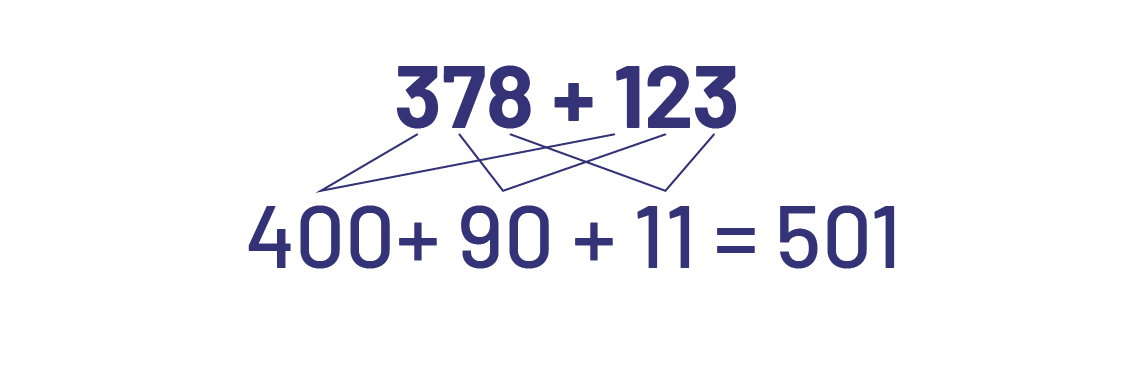
Source: translated from Guide d'enseignement efficace des mathématiques de la 4e à la 6e année, Numération et sens du nombre, Fascicule 1, Nombres naturels, p. 76.

 represents the whole)
represents the whole) represents the whole)
represents the whole)